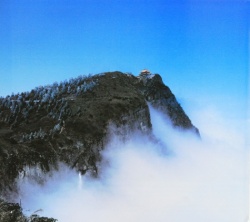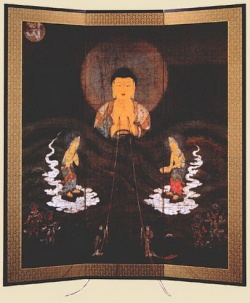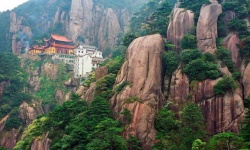Difference between revisions of "Sacred Mountains of China"
| Line 1: | Line 1: | ||
[[File:Mt-Emei-China.jpg|thumb|250px|]] | [[File:Mt-Emei-China.jpg|thumb|250px|]] | ||
| − | The Sacred Mountains of China are divided into several groups. The Five Great Mountains (simplified Chinese: 五岳; traditional Chinese: 五嶽; pinyin: Wǔyuè) refers to five of the most renowned mountains in Chinese history, | + | The Sacred Mountains of China are divided into several groups. The Five Great Mountains (simplified Chinese: 五岳; traditional Chinese: 五嶽; pinyin: Wǔyuè) refers to five of the most renowned mountains in Chinese history, and they were the subjects of imperial pilgrimage by emperors throughout ages. Although not traditionally categorized as either Taoist or Buddhist mountains, these five mountains have a strong presence of both, especially that of Taoism. The group associated with Buddhism is referred to as the Four Sacred Mountains of Buddhism (Chinese: 四大佛教名山), and the group associated with Taoism is referred to as the Four Sacred Mountains of Taoism (Chinese: 四大道教名山). |
| − | The sacred mountains have all been important destinations for pilgrimage, the Chinese expression for pilgrimage (simplified Chinese: 朝圣; traditional Chinese: 朝聖; pinyin: cháoshèng) is a shortened version of an expression which means "paying respect to a holy mountain" (simplified Chinese: 朝拜圣山; traditional Chinese: 朝拜聖山; pinyin: cháobài shèng shān).The Five Great Mountains | + | The sacred mountains have all been important destinations for pilgrimage, the Chinese expression for pilgrimage (simplified Chinese: 朝圣; traditional Chinese: 朝聖; pinyin: cháoshèng) is a shortened version of an expression which means "paying respect to a holy mountain" (simplified Chinese: 朝拜圣山; traditional Chinese: 朝拜聖山; pinyin: cháobài shèng shān). |
| − | + | ||
| + | ==The Five Great Mountains== | ||
The Five Great Mountains or Wu Yue are arranged according to the five cardinal directions of Chinese geomancy, which includes the center as a direction. The grouping of the five mountains appeared during the Warring States Period, and the term of Wu Yue (Five Summit) was made famous during the reign of Emperor Wudi of the Western Han Dynasty 140-87 BC. During the next two thousand years the worship of the five mountains became ingrained in Chinese culture. The five mountains are among the best-known natural landmarks in Chinese history, and since the early periods in Chinese history, they have been the ritual sites of imperial worship and sacrifice by various emperors. Although these five mountains are not traditionally canonized as having any exclusive religious affiliations, many of them have a strong Taoist presence, thus the five mountains are also grouped by some as part of "Sacred Taoist Mountains". There are also various Buddhist temples and Confucian academies built on these mountains. | The Five Great Mountains or Wu Yue are arranged according to the five cardinal directions of Chinese geomancy, which includes the center as a direction. The grouping of the five mountains appeared during the Warring States Period, and the term of Wu Yue (Five Summit) was made famous during the reign of Emperor Wudi of the Western Han Dynasty 140-87 BC. During the next two thousand years the worship of the five mountains became ingrained in Chinese culture. The five mountains are among the best-known natural landmarks in Chinese history, and since the early periods in Chinese history, they have been the ritual sites of imperial worship and sacrifice by various emperors. Although these five mountains are not traditionally canonized as having any exclusive religious affiliations, many of them have a strong Taoist presence, thus the five mountains are also grouped by some as part of "Sacred Taoist Mountains". There are also various Buddhist temples and Confucian academies built on these mountains. | ||
| − | East Great Mountain (Dōngyuè): Tài Shān | + | |
| + | ===East Great Mountain (Dōngyuè): [[Mount Tai|Tài Shān]]=== | ||
Chinese: 泰山; ; "Tranquil Mountain", Shāndōng Province, 1,545 m, 36°15′N 117°06′E | Chinese: 泰山; ; "Tranquil Mountain", Shāndōng Province, 1,545 m, 36°15′N 117°06′E | ||
| − | West Great Mountain (Xīyuè): Huà Shān | + | |
| + | ===West Great Mountain (Xīyuè): [[Mount Hua|Huà Shān]]=== | ||
simplified Chinese: 华山; traditional Chinese: 華山; "Splendid Mountain", Shănxī Province, 1,997 m 34°29′N 110°05′E | simplified Chinese: 华山; traditional Chinese: 華山; "Splendid Mountain", Shănxī Province, 1,997 m 34°29′N 110°05′E | ||
| − | South Great Mountain (Nányuè): Héng Shān (Hunan) | + | |
| + | ===South Great Mountain (Nányuè): [[Mount Heng (Hunan)|Héng Shān (Hunan)]]=== | ||
Chinese: 衡山; ; "Balancing Mountain", Húnán Province, 1,290 m, 27.254798°N 112.655743°E | Chinese: 衡山; ; "Balancing Mountain", Húnán Province, 1,290 m, 27.254798°N 112.655743°E | ||
| − | North Great Mountain (Běiyuè): Héng Shān (Shanxi) | + | |
| + | ===North Great Mountain (Běiyuè): [[Mount Heng (Shanxi)|Héng Shān (Shanxi)]]=== | ||
[[File:Snap1(8).jpg|thumb|250px|]] | [[File:Snap1(8).jpg|thumb|250px|]] | ||
simplified Chinese: 恒山; traditional Chinese: 恆山; "Permanent Mountain", Shānxī Province, 2,017 m, 39°40′26″N 113°44′08″E | simplified Chinese: 恒山; traditional Chinese: 恆山; "Permanent Mountain", Shānxī Province, 2,017 m, 39°40′26″N 113°44′08″E | ||
| − | Center Great Mountain (Zhōngyuè): Sōng Shān | + | |
| + | ===Center Great Mountain (Zhōngyuè): [[Mount Song|Sōng Shān]]=== | ||
Chinese: 嵩山; ; "Lofty Mountain", Hénán Province, 1,494 m, 34°29′5″N 112°57′37″E | Chinese: 嵩山; ; "Lofty Mountain", Hénán Province, 1,494 m, 34°29′5″N 112°57′37″E | ||
| Line 25: | Line 31: | ||
According to Chinese mythology, the Five Great Mountains originated from the body of Pangu (盤古/盘古 Pángǔ), the first being and the creator of the world. Because of its eastern location, Mount Tài is associated with the rising sun which signifies birth and renewal. Due to this interpretation, it is often regarded as the most sacred of the Five Great Mountains. In accordance with its special position, Mount Tài is believed to have been formed out of Pangu's head. Mount Heng in Hunan is believed to be a remainder of Pangu's right arm, Mount Heng in Shanxi of his left arm, Mount Song of his belly, and Mount Hua of his feet | According to Chinese mythology, the Five Great Mountains originated from the body of Pangu (盤古/盘古 Pángǔ), the first being and the creator of the world. Because of its eastern location, Mount Tài is associated with the rising sun which signifies birth and renewal. Due to this interpretation, it is often regarded as the most sacred of the Five Great Mountains. In accordance with its special position, Mount Tài is believed to have been formed out of Pangu's head. Mount Heng in Hunan is believed to be a remainder of Pangu's right arm, Mount Heng in Shanxi of his left arm, Mount Song of his belly, and Mount Hua of his feet | ||
| − | The Four Sacred Mountains of Buddhism | + | |
| − | + | ==The Four Sacred Mountains of Buddhism== | |
The Buddhist "Four Sacred Mountains" in China are: | The Buddhist "Four Sacred Mountains" in China are: | ||
| − | Wǔtái Shān | + | |
| + | ===[[Wutai Shan|Wǔtái Shān]]=== | ||
Chinese: 五台山; "Five-Platform Mountain", Shānxī Province, 3,058 m, 39°04′45″N 113°33′53″E | Chinese: 五台山; "Five-Platform Mountain", Shānxī Province, 3,058 m, 39°04′45″N 113°33′53″E | ||
Wutai is the home of the Bodhisattva of wisdom, Manjusri or Wenshu (Traditional: 文殊) in Chinese. | Wutai is the home of the Bodhisattva of wisdom, Manjusri or Wenshu (Traditional: 文殊) in Chinese. | ||
| − | Éméi Shān | + | |
| + | ===[[Emei Shan|Éméi Shān]]=== | ||
| + | |||
[[File:Sity-TN.jpg|thumb|250px|]] | [[File:Sity-TN.jpg|thumb|250px|]] | ||
Chinese: 峨嵋山; ; "High and Lofty Mountain", Sìchuān Province, 3,099 m, 29°31′11″N 103°19′57″E | Chinese: 峨嵋山; ; "High and Lofty Mountain", Sìchuān Province, 3,099 m, 29°31′11″N 103°19′57″E | ||
| − | The patron bodhisattva of Emei is Samantabhadra, known in Chinese as Puxian (普贤菩萨). | + | The patron [[bodhisattva]] of Emei is Samantabhadra, known in Chinese as Puxian (普贤菩萨). |
| − | Jiǔhuá Shān | + | |
| + | ===[[Jiuhuashan|Jiǔhuá Shān]]=== | ||
simplified Chinese: 九华山; traditional Chinese: 九華山; "Nine Glories Mountain", Ānhuī Province, 1,341 m, 30°28′56″N 117°48′16″E | simplified Chinese: 九华山; traditional Chinese: 九華山; "Nine Glories Mountain", Ānhuī Province, 1,341 m, 30°28′56″N 117°48′16″E | ||
Many of the mountain's shrines and temples are dedicated to Ksitigarbha (known in Chinese as Dìzàng, Chinese: 地藏, in Japanese as Jizō), who is a bodhisattva and protector of beings in hell realms | Many of the mountain's shrines and temples are dedicated to Ksitigarbha (known in Chinese as Dìzàng, Chinese: 地藏, in Japanese as Jizō), who is a bodhisattva and protector of beings in hell realms | ||
| − | Pǔtuó Shān | + | |
| + | ===[[Putuo Shan|Pǔtuó Shān]]=== | ||
Chinese: 普陀山; ; "Mount Potalaka", Zhèjiāng Province, 284 m 30°00′35″N 122°23′06″E | Chinese: 普陀山; ; "Mount Potalaka", Zhèjiāng Province, 284 m 30°00′35″N 122°23′06″E | ||
This mountain is considered the bodhimanda of Avalokitesvara (Guan Yin), bodhisattva of compassion. | This mountain is considered the bodhimanda of Avalokitesvara (Guan Yin), bodhisattva of compassion. | ||
| − | The Four Sacred Mountains of Taoism | + | |
| − | + | ||
| + | ==The Four Sacred Mountains of Taoism== | ||
The "Four Sacred Mountains" of Taoism are: | The "Four Sacred Mountains" of Taoism are: | ||
| − | Wǔdāng Shān | + | |
| + | ===[[Wudang_Mountains|Wǔdāng Shān]]=== | ||
simplified Chinese: 武当山; traditional Chinese: 武當山; northwestern part of Hubei. Main peak: 1612m. 32°40′0″N 111°00′4″E. | simplified Chinese: 武当山; traditional Chinese: 武當山; northwestern part of Hubei. Main peak: 1612m. 32°40′0″N 111°00′4″E. | ||
| − | Lónghŭ Shān | + | |
| + | ===[[Mount_Longhu|Lónghŭ Shān]]=== | ||
[[File:Jur2.jpg|thumb|250px|]] | [[File:Jur2.jpg|thumb|250px|]] | ||
Simplified Chinese: 龙虎山; Traditional Chinese: 龍虎山; literally "Dragon Tiger Mountain", Jiangxi. Main peak: 247.4m. | Simplified Chinese: 龙虎山; Traditional Chinese: 龍虎山; literally "Dragon Tiger Mountain", Jiangxi. Main peak: 247.4m. | ||
| − | Qíyūn Shān | + | |
| + | ===[[Mount_Qiyun|Qíyūn Shān]]=== | ||
simplified Chinese: 齐云山; traditional Chinese: 齊雲山; literally "As High as the Clouds", Anhui. Main peak: 585m. | simplified Chinese: 齐云山; traditional Chinese: 齊雲山; literally "As High as the Clouds", Anhui. Main peak: 585m. | ||
| − | Qīngchéng Shān | + | |
| + | ===[[Mount_Qingcheng|Qīngchéng Shān]]=== | ||
Chinese: 青城山; ; Dujiangyan, Sichuan. Main peak: 1260m (surveyed in 2007). famous for "The most secluded place in China". 31°01′07.63″N 103°32′47.36″E. | Chinese: 青城山; ; Dujiangyan, Sichuan. Main peak: 1260m (surveyed in 2007). famous for "The most secluded place in China". 31°01′07.63″N 103°32′47.36″E. | ||
| + | {{W}} | ||
| − | |||
[[Category:Buddhist Pilgrimages]] | [[Category:Buddhist Pilgrimages]] | ||
| Line 73: | Line 89: | ||
[[Category:Sacred Mountains of China]] | [[Category:Sacred Mountains of China]] | ||
[[Category:Buddhist Terms]] | [[Category:Buddhist Terms]] | ||
| − | |||
| − | |||
Revision as of 07:24, 25 May 2013
The Sacred Mountains of China are divided into several groups. The Five Great Mountains (simplified Chinese: 五岳; traditional Chinese: 五嶽; pinyin: Wǔyuè) refers to five of the most renowned mountains in Chinese history, and they were the subjects of imperial pilgrimage by emperors throughout ages. Although not traditionally categorized as either Taoist or Buddhist mountains, these five mountains have a strong presence of both, especially that of Taoism. The group associated with Buddhism is referred to as the Four Sacred Mountains of Buddhism (Chinese: 四大佛教名山), and the group associated with Taoism is referred to as the Four Sacred Mountains of Taoism (Chinese: 四大道教名山).
The sacred mountains have all been important destinations for pilgrimage, the Chinese expression for pilgrimage (simplified Chinese: 朝圣; traditional Chinese: 朝聖; pinyin: cháoshèng) is a shortened version of an expression which means "paying respect to a holy mountain" (simplified Chinese: 朝拜圣山; traditional Chinese: 朝拜聖山; pinyin: cháobài shèng shān).
The Five Great Mountains
The Five Great Mountains or Wu Yue are arranged according to the five cardinal directions of Chinese geomancy, which includes the center as a direction. The grouping of the five mountains appeared during the Warring States Period, and the term of Wu Yue (Five Summit) was made famous during the reign of Emperor Wudi of the Western Han Dynasty 140-87 BC. During the next two thousand years the worship of the five mountains became ingrained in Chinese culture. The five mountains are among the best-known natural landmarks in Chinese history, and since the early periods in Chinese history, they have been the ritual sites of imperial worship and sacrifice by various emperors. Although these five mountains are not traditionally canonized as having any exclusive religious affiliations, many of them have a strong Taoist presence, thus the five mountains are also grouped by some as part of "Sacred Taoist Mountains". There are also various Buddhist temples and Confucian academies built on these mountains.
East Great Mountain (Dōngyuè): Tài Shān
Chinese: 泰山; ; "Tranquil Mountain", Shāndōng Province, 1,545 m, 36°15′N 117°06′E
West Great Mountain (Xīyuè): Huà Shān
simplified Chinese: 华山; traditional Chinese: 華山; "Splendid Mountain", Shănxī Province, 1,997 m 34°29′N 110°05′E
South Great Mountain (Nányuè): Héng Shān (Hunan)
Chinese: 衡山; ; "Balancing Mountain", Húnán Province, 1,290 m, 27.254798°N 112.655743°E
North Great Mountain (Běiyuè): Héng Shān (Shanxi)
simplified Chinese: 恒山; traditional Chinese: 恆山; "Permanent Mountain", Shānxī Province, 2,017 m, 39°40′26″N 113°44′08″E
Center Great Mountain (Zhōngyuè): Sōng Shān
Chinese: 嵩山; ; "Lofty Mountain", Hénán Province, 1,494 m, 34°29′5″N 112°57′37″E
Alternatively, these mountains are sometimes referred to by the respective directions, i.e., as the "Northern Great Mountain" (北嶽/北岳 Běi Yuè), "Southern Great Mountain" (南嶽/南岳 Nán Yuè), "Eastern Great Mountain" (東嶽/东岳 Dōng Yuè), "Western Great Mountain" (西嶽/西岳 Xī Yuè), and "Central Great Mountain" (中嶽/中岳 Zhōng Yuè).
According to Chinese mythology, the Five Great Mountains originated from the body of Pangu (盤古/盘古 Pángǔ), the first being and the creator of the world. Because of its eastern location, Mount Tài is associated with the rising sun which signifies birth and renewal. Due to this interpretation, it is often regarded as the most sacred of the Five Great Mountains. In accordance with its special position, Mount Tài is believed to have been formed out of Pangu's head. Mount Heng in Hunan is believed to be a remainder of Pangu's right arm, Mount Heng in Shanxi of his left arm, Mount Song of his belly, and Mount Hua of his feet
The Four Sacred Mountains of Buddhism
The Buddhist "Four Sacred Mountains" in China are:
Wǔtái Shān
Chinese: 五台山; "Five-Platform Mountain", Shānxī Province, 3,058 m, 39°04′45″N 113°33′53″E
Wutai is the home of the Bodhisattva of wisdom, Manjusri or Wenshu (Traditional: 文殊) in Chinese.
Éméi Shān
Chinese: 峨嵋山; ; "High and Lofty Mountain", Sìchuān Province, 3,099 m, 29°31′11″N 103°19′57″E
The patron bodhisattva of Emei is Samantabhadra, known in Chinese as Puxian (普贤菩萨).
Jiǔhuá Shān
simplified Chinese: 九华山; traditional Chinese: 九華山; "Nine Glories Mountain", Ānhuī Province, 1,341 m, 30°28′56″N 117°48′16″E
Many of the mountain's shrines and temples are dedicated to Ksitigarbha (known in Chinese as Dìzàng, Chinese: 地藏, in Japanese as Jizō), who is a bodhisattva and protector of beings in hell realms
Pǔtuó Shān
Chinese: 普陀山; ; "Mount Potalaka", Zhèjiāng Province, 284 m 30°00′35″N 122°23′06″E
This mountain is considered the bodhimanda of Avalokitesvara (Guan Yin), bodhisattva of compassion.
The Four Sacred Mountains of Taoism
The "Four Sacred Mountains" of Taoism are:
Wǔdāng Shān
simplified Chinese: 武当山; traditional Chinese: 武當山; northwestern part of Hubei. Main peak: 1612m. 32°40′0″N 111°00′4″E.
Lónghŭ Shān
Simplified Chinese: 龙虎山; Traditional Chinese: 龍虎山; literally "Dragon Tiger Mountain", Jiangxi. Main peak: 247.4m.
Qíyūn Shān
simplified Chinese: 齐云山; traditional Chinese: 齊雲山; literally "As High as the Clouds", Anhui. Main peak: 585m.
Qīngchéng Shān
Chinese: 青城山; ; Dujiangyan, Sichuan. Main peak: 1260m (surveyed in 2007). famous for "The most secluded place in China". 31°01′07.63″N 103°32′47.36″E.



